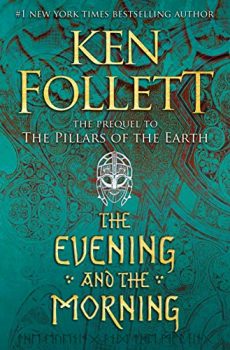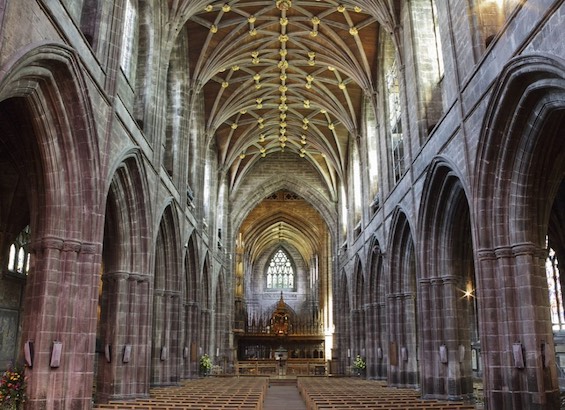
For decades Welsh novelist Ken Follett was best known for his bestselling thrillers, beginning with Eye of the Needle (1978), which established his reputation as a master of the craft. A decade later he indulged his longstanding passion for the architecture of classic European cathedrals when he published Pillars of the Earth (1989), the inaugural volume in the Kingsbridge Trilogy. And now, just three years after the publication of A Column of Fire completed the trilogy, he has produced a prequel, which deftly sets the scene for the three volumes that follow it chronologically.
Follett set the now-four books in the Kingsbridge series in England at intervals of about two centuries. The Evening and the Morning takes place during the years 997 to 1007 CE. The stories in the original trilogy unfold in the twelfth, fourteenth, and sixteenth centuries, respectively. Taken as a whole, they provide a vivid picture of England’s awakening from the Dark Ages to its ascension as a world power under Elizabeth I. Follett is a dogged researcher as well as an able storyteller. Despite the staggering length of the series—a total of nearly four thousand pages!—these tales skip and hum along. They prove an easy read, and no wonder. More than forty million copies of the first three books have already been sold.
The Evening and the Morning (Kingsbridge #1) by Ken Follett (2020) 926 pages ★★★★☆

An English builder and a Norman noblewoman in a love story
The plot in The Evening and the Morning revolves around two young people. Edgar is the youngest of three children of a shipbuilder in the English port of Combe. Ragna—more formally known as Lady Ragnhild—is the daughter of Court Herbert of Cherbourg, a Norman noble. No reader will be surprised that these two appealing youngsters—Edgar is eighteen in 997, and Ragna is twenty—will meet, suffer through a harrowing series of misadventures, and fall in love. Nor should anyone familiar with the Kingsbridge Trilogy be in doubt that Edgar will turn from building ships to constructing the cathedral that is the centerpiece of the series. But that will only happen nearly all the way at the end of this 900-page doorstopper.
A compelling picture of life in medieval England
Follett paints a compelling picture of life in England on the cusp of the Late Middle Ages. The country has yet to be united. To the northeast, Danes rule the land. Further north, Gaelic-speaking Scots roam free beyond the English realm, as did the “Britons, people from the wild western fringes of civilization, Wales and Cornwall and Ireland.” What today is Great Britain was a linguistic soup with a dozen or more languages and dialects colliding in mutual incomprehension: what today we call Old English (or Anglo-Saxon), Old Norse, Welsh, and many varieties of Gaelic. And few outside the Church and a handful of nobles could read and write.
A life lived in a world lit only by fire
- Edgar’s “Ma and Pa had taught their sons to keep themselves fresh by bathing at least once a year.” But many never bathed, considering the practice unhealthy. Occasionally, people drank water from wells or streams, but for the most part ale was the drink of choice, with wine or occasionally mead optional for those with greater means.
- “In principle the Church preferred priests to be celibate, but the rule was broken more often than it was kept, and even married bishops were not unheard of.” The Church also frowned on polygamy, but ineffectively. “Most men who could afford it had more than one wife, or a wife and one or more concubines, and slave girls, too. The church did not have jurisdiction over marriage.”
- Follett conveys an interesting sense of the money then in circulation. Under King Ethelred, the currency was stable. The basic unit of exchange is the silver penny. Two hundred forty pennies formed a pound—literally, a pound of silver. “A penny would buy half a dozen chickens or a quarter of a sheep. For cheaper items, a penny had to be cut into two halfpennies or four farthings.”
Living under threat of starvation in an unstable land
King Ethelred (966-1016) sits on England’s throne but controls only the south of the island in this fascinating prequel to the Kingsbridge Trilogy. He’s a weak monarch, rarely able to enforce his directives to the noble families who control the towns, villages, and farms of the land. Ealdormans (later called earls) and their retainers, known as thanes (called knights in Normandy), exercised power at the local level, often in defiance of the king.
In a modest effort to counteract them, the king appointed sheriffs to collect taxes and administer justice in some locations. Inevitably, this set up conflict with the officials already in place locally and underlined the essential instability of the country at the turn of the millennium. But little about this political reality affects day-to-day life in a country where all but a tiny elite are poor, facing starvation in the event of a poor harvest, and “about one person in ten was a slave.”
More significantly still, the king can only forestall the frequent raids on the English coast by paying a rich ransom in silver each year. History tells us the Danes were the raiders; Follett portrays them as Vikings based in Normandy, perhaps anticipating the Norman Invasion six decades later. (In the Acknowledgments, Follett notes that “while thanking my historical advisers, I must add that I have not always followed their advice.”) And The Evening and the Morning opens with a Viking raid on Combe, where Edgar loses his father, his family’s modest and hard-earned wealth, and the woman he loves. Viking attacks, complete with all the expected murder, rape, and pillage, occur repeatedly throughout the story.
So, why is this such a compelling read?
What would keep a reader going through the more than 900 pages of this prequel to the Kingsbridge Trilogy? To me, three major factors stand out:
- The focus throughout is on the two principal characters, whose growth over the decade depicted in the book is both marked and credible. The storyline is simple, straightforward, and energetic.
- Rich historical detail portrays a society in the throes of change, and change is the stuff of fiction (and of life). By following how Edgar and Ragna navigate through the perilous years not long before the Norman Invasion, we learn how English society was structured and life was lived in the shadow of the medieval Christian church.
- And for a historical fiction fan like me, there are the additional pleasures of discovering the sights and smells and sounds—and the ever-present dangers—of life in a faraway place and time.
However, if you’re squeamish, you may not enjoy this novel. The violence is never prurient. But it’s fully as abundant as the known history of the period would suggest. Murder, of course—frequent enough to populate a thriller with a cemetery full of corpses. Rape, too. Torture. But what else could you expect from a novel centered around Viking raids and vicious, predatory noblemen? And the violence is essential to set the scene for the Kingsbridge Trilogy that follows, when life in England gradually became more predictable and less dangerous.
For related reading
I’ve read all three books in the Kingsbridge Trilogy, of which The Evening and the Morning is a prequel. But I’ve also read the fourth book in the series, A Column of Fire (Ken Follett’s 16th-century Kingsbridge saga: Christians killing Christians), and the fifth, The Armor of Light (The Kingsbridge Saga moves to the Industrial Revolution).
I’ve also reviewed the author’s best-known spy thriller, Eye of the Needle (The 40th anniversary edition of Ken Follett’s classic WWII spy novel) and Never (Is a new world war possible by accident?).
For an excellent popular history of the medieval era, see Powers and Thrones: A New History of the Middle Ages by Dan Jones (Change in the Middle Ages came thick and fast).
For another excellent novel about the building of a medieval cathedral, see Cathedral by Ben Hopkins (This beautifully written novel illuminates life in medieval Europe).
You might also check out my post, 20 most enlightening historical novels.
And you can always find my most popular reviews, and the most recent ones, on the Home Page.


























